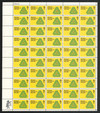
1966 5c National Park Service
# 1314 - 1966 5c National Park Service
$0.35 - $22.00
U.S. #1314
1966 5¢ National Park Service
Issue Date: August 25, 1966
City: Yellowstone National Park, WY
Quantity: 119,535,000
Quantity: 119,535,000
Printed By: Bureau of Engraving and Printing
Printing Method: Lithographed, engraved
Perforations: 11
Color:Yellow, black and green
Issued at Yellowstone National Park, this stamp celebrates the 50th anniversary of the United States Park Service.
U.S. #1314
1966 5¢ National Park Service
Issue Date: August 25, 1966
City: Yellowstone National Park, WY
Quantity: 119,535,000
Quantity: 119,535,000
Printed By: Bureau of Engraving and Printing
Printing Method: Lithographed, engraved
Perforations: 11
Color:Yellow, black and green
Issued at Yellowstone National Park, this stamp celebrates the 50th anniversary of the United States Park Service.









